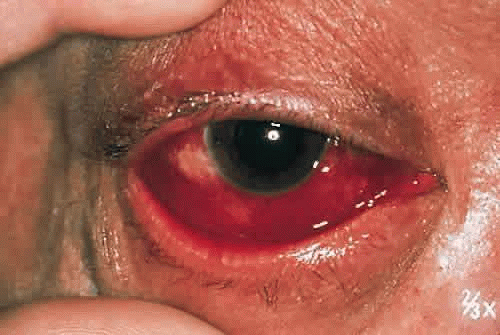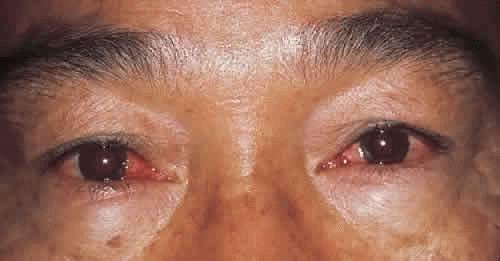Enterovirus and Coxsackievirus
Eiichi Uchio
Human enteroviruses make up one genus in the family of Picornaviridae, which also contains the genera Rhinovirus, Hepatovirus, Cardiovirus, and Aphthovirus. The members of the human Enterovirus genus include the polioviruses, the coxsackievirus groups A and B, the echoviruses, and the enteroviruses 68 through 71 (Table 1). Human enteroviruses inhabit the alimentary tract, and most can infect the central nervous system. The first enterovirus, a group A coxsackievirus, was recovered from suckling mice that had been inoculated with a cell-free filtered stool from children suffering from paralysis in Coxsackie, New York in 1948.1 The first group B coxsackievirus was also isolated in 1948.2
Enterovirus 70 (EV70) and an antigenic variant of coxsackievirus A24 (CA24v) are the two major pathogenic agents inducing acute hemorrhagic conjunctivitis (AHC). The ocular symptoms caused by EV70 and CA24v are clinically indistinguishable and constitute the AHC syndrome. Therefore, AHC should be used as the term representing an enteroviral eye disease characterized by the AHC syndrome. AHC in this chapter includes conditions caused not only by EV70 and CA24v but also by echoviruses 7 and 11 whose epidemic occurred in Sweden in 1977; AHC caused by adenovirus type 11 is excluded.
ACUTE HEMORRHAGIC CONJUNCTIVITIS
EPIDEMIOLOGY
Explosive epidemics of AHC were initially reported in West Africa and Indonesia in 1969 with subsequent pandemic spread.3 A causative agent of AHC was first recovered by Kono and coworkers4 from conjunctival scrapings of patients with AHC. The isolate was identified as a new type of enterovirus when the first outbreak of AHC in Japan occurred, during the worldwide pandemic of 1969 to 1972. The first pandemic of AHC was caused by EV70 in Africa, Southeast Asia (including Singapore and Hong Kong), Japan, and India in 1969 to 1971, with several million cases. In 1970, a year before EV70 was found, Yin-Murphy5 reported a large outbreak of epidemic conjunctivitis in Singapore, where she isolated a new enterovirus from the conjunctival scrapings of patients. The virus was identified as the causative agent of the disease, which was called Singapore epidemic conjunctivitis by Lin and Yin-Murphy.6 The virus was later renamed CA24v.7
Epidemics of this disease recurred during the last quarter of the 20th century. Both viruses cause the same disease, according to viral isolation, serologic investigation, and the reverse transcription-polymerase chain reaction (RT-PCR) method. AHC spread throughout Southeast Asia and first occurred outside Asia in American Samoa in 1986, where nearly half the population was affected.8 After a sporadic outbreak in French Polynesia in 1982, EV70 was introduced into the Western hemisphere, including the United States.9 CA24v was responsible for the epidemics of 197510 and 1985.11,12
There is a noticeable difference in the geographic distribution of these two viruses. EV70 has widely spread to various parts of the world from its original focus in West Africa, and it has so far caused two major pandemics in 1969 to 1972 and 1980 to 1982. AHC caused by CA24v first appeared in Singapore and Malaysia in 1970, and since then, AHC epidemics have been intermittently observed only in Southeast and East Asia and India.
CLINICAL CHARACTERISTICS
The onset is sudden and alarming. After beginning with one eye, the other often becomes inflamed in a matter of hours. Most patients develop signs in the second eye within 1 to 3 days (Fig. 1). Pain accompanies the other symptoms.
The most common symptoms are a profuse and predominantly watery discharge, a foreign body sensation, burning, photophobia, swelling of the eyelids, and pain in the upper eyelid that is aggravated on bending over. Although patients often complained of coryza, fewer than 5% showed systemic manifestations, such as fever or malaise. Ocular symptoms are often usually severe enough, however, to disrupt routine activities for several days.
Signs of AHC caused by EV70 and CA24v are similar, and it is impossible to determine the causative virus from clinical characteristics. Edematous swelling of the lid occurs in 72% to 100% of patients, although severity varies. Swelling usually subsides within 3 or 4 days. Preauricular lymph nodes become enlarged and palpable in 65% of patients, and approximately 80% are tender.13 The upper conjunctivae become inflamed from a mild to a severe degree, with injection, infiltration, and follicle formation. In moderately inflamed eyes, the fornix is reddened and cloudy, obscuring blood vessels.
The most characteristic finding is marked hemorrhagic involvement of the bulbar conjunctival and subconjunctival layers. Punctate hemorrhages often appear within a few hours of onset of symptoms and rapidly coalesce to form larger hemorrhagic patches (Fig. 2). These patches tend to form ridges concentric with the corneoscleral limbus and occasionally become confluent (Fig. 3). Although 40% of patients have with unilateral involvement, more than 90% have bilateral disease when examined the next day.
 Fig. 3. Typical conjunctival hemorrhage in the late phase of acute hemorrhagic conjunctivitis. Blot conjunctival hemorrhages form a ridge at the corneoscleral limbus 6 days after the onset. |
Corneal complications are generally rare. The incidence of epithelial keratitis ranges from 0% to 30% (Fig. 4). Extraocular symptoms and signs are usually mild and resolve without sequelae.
 Fig. 4. Corneal complication of acute hemorrhagic conjunctivitis. Moderate epithelial keratitis and conjunctival hyperemia are observed. |
Most symptoms resolve by the fourth day of illness, as do most physical findings. The most persistent signs are conjunctival hemorrhages and follicles, which may aid physicians in making the diagnosis of AHC when patients present during the convalescent phase of disease.
VIROLOGY
VIRAL MORPHOLOGY AND PHYSICOCHEMICAL PROPERTIES
The virions of EV70 and CA24v are spherical and have diameters of 30 ± 1 nm, showing a typical enterovirus morphology. Virions of these viruses have a buoyant density of 1.34 g/cm3 in CsCl2, and their sedimentation coefficient is 160S in sucrose.14,15 The virion consists of a single-stranded RNA genome and four structural proteins, similar to other enteroviruses.16
The sedimentation coefficient of the genome RNA is 34S, and its molecular weight is 2.5 × 106 daltons.14,15 The single-stranded genomic RNA has positive-strand sense, and it codes in a single open reading frame for the four capsid proteins and additionally for functional proteins with, for example, RNA polymerase and protease activities. The genome RNA contains 7,391 nucleotides.
The capsid consists of 60 protomers, each of which contains four nonglycosylated virus proteins. The capsid proteins are virus protein (VP) 1 (molecular weight, 35 kilodaltons), VP2 (28 kilodaltons), VP3 (27 kilodaltons), and VP4 (9 kilodaltons). VP4 is myristoylated at its N-terminus. Structure analysis by x-ray crystallography and biochemical accessibility studies have shown that the capsid proteins VP1, VP2, and VP3 are at the capsid surface, whereas VP4 is covered inside the capsid shell and has contact to the viral RNA (Fig. 5). VP1, VP2, and VP3 together make up a pseudoequivalent packing arrangement in the capsid. VP1 and VP3 form a depression or canyon (approximately 2.5 nm deep and up to 3 nm wide) that is oriented around the fivefold symmetry axis of the capsid. It is proposed that the canyon is the recognition site for the virus-specific receptor; this canyon hypothesis has also been described for the related picornavirus, human rhinovirus 14.17
BIOLOGICAL PROPERTIES
Portal of Entry
For most enteroviruses, the primary site of infection is the alimentary tract, where the viruses replicate and produce systemic infection through viremia. For EV70 and CA24v, however, the primary infection site seems to be the conjunctiva, and there has been no definite evidence to suggest active replication of these viruses in the gastrointestinal tract. In the occasional case, these viruses are recovered from the feces of patients with AHC. Although one cannot completely exclude the possibility that EV70 and CA24v replicated in the intestine, in such cases, it is more reasonable to assume that these viruses grew in the conjunctiva, passed from the nasopharynx into the alimentary tract, and were then incidentally recovered from feces. This assumption is also supported by in vitro findings that EV70 replicates better at 32°C to 34°C than at 37°C and usually does not replicate at 39°C,18,19 suggesting that the virus cannot readily grow in the alimentary tract. This temperature-sensitive growth of EV70 suggests that these viruses have acquired human pathogenicity as a result of their adaptation to the lower temperature of the ocular surface through evolution. However, in contrast, as for CA24v, no difference was observed in the isolation rate in HeLa cell culture at 33°C and those incubated at 37°C.20,21 Studies to investigate molecular events leading to a temperature-sensitive defect in EV70 replication showed that viral RNA synthesis was blocked at the nonpermissive temperature (39°C).22,23 The temperature-sensitive defect of EV70 replication is most likely the result of lack of uridylation of VPg at the restricted temperature.24
Stay updated, free articles. Join our Telegram channel

Full access? Get Clinical Tree





